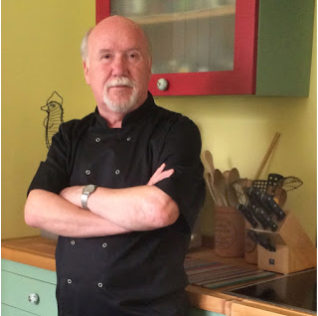Pickled Quince
Pickled Quince
 Two good friends of mine, Ros and Gary, gave me some quinces recently which I have never prepared before although but I have often had quince jelly (known as Membrillo in Spain) which goes particularly well with hard cheese, especially a nice mature Manchego. I have to say that Ros's quince jelly is as good as any I have tried in Spain.
Two good friends of mine, Ros and Gary, gave me some quinces recently which I have never prepared before although but I have often had quince jelly (known as Membrillo in Spain) which goes particularly well with hard cheese, especially a nice mature Manchego. I have to say that Ros's quince jelly is as good as any I have tried in Spain.Knowing I couldn't improve on that that I decided to try pickling them instead, something which I have done quite a lot of recently as it is a great way of preserving food and adds an interesting accompaniment to dishes.

 The first thing to do is to prepare your pickling liquid. In a saucepan pour in some apple cider vinegar, wine vinegar or half and half (allow approximately 3 cups of vinegar per pound of fruit). Add two teaspoons of pink or black pepper corns, a tablespoon of juniper berries and two bay leaves. Bring this to the boil, reduce heat and simmer for a few minutes to infuse the flavours. Take off the heat and allow to cool, transferring this to a larger saucepan at this stage.
The first thing to do is to prepare your pickling liquid. In a saucepan pour in some apple cider vinegar, wine vinegar or half and half (allow approximately 3 cups of vinegar per pound of fruit). Add two teaspoons of pink or black pepper corns, a tablespoon of juniper berries and two bay leaves. Bring this to the boil, reduce heat and simmer for a few minutes to infuse the flavours. Take off the heat and allow to cool, transferring this to a larger saucepan at this stage.
The next, and most tricky part, is to peal, core and chop the quince into bite sized pieces. You will need to do this quite quickly as the quince will turn brown as soon as they are exposed to the air.
As soon as you have chopped one put the pieces into the cooling liquid, don't wait until you have prepared them all.
If you do they will be brown and look unappetising in the jars.
 Forget trying to get regular size or uniform shaped pieces, it wont happen as quince vary in size and shape and have a very hard core. You will need a peeler and a sharp knife to do this so be careful as always.
Forget trying to get regular size or uniform shaped pieces, it wont happen as quince vary in size and shape and have a very hard core. You will need a peeler and a sharp knife to do this so be careful as always.You will need to have some sterilised jars ready, recycled jam jars work just fine. Wash thoroughly and sterilise the jars and lids with boiling water or in a hot oven, handle with care.
Once you have added all of the quince pieces, return the saucepan to the heat and once again bring to the boil and then reduce to a simmering point.
 Keep a close watch at this point as these should only take 4 to 5 minutes of simmering. Check with a sharp knife and once they are just starting to yield remove the pan from the heat.
Keep a close watch at this point as these should only take 4 to 5 minutes of simmering. Check with a sharp knife and once they are just starting to yield remove the pan from the heat. Spoon into sterilised jars and top up with the liquid making sure you split the spices evenly between the jars.
As with all pickles they will benefit from being left alone for a couple of months. The flavours will develop and the quince will become tender and delicious.
Disclaimer: The suggestions and tips on these blog pages are meant to be used in conjunction with common sense. Keeping your family healthy is the priority. Do not use food that is unfit for human consumption and always follow sensible food hygiene guidelines.
http://www.nhs.uk/Livewell/homehygiene/Pages/food-leftovers-safety.aspx
Always be careful in the kitchen, we accept no responsibility for any accidents caused as a direct or indirect result of preparing any of these dishes. Children should not be allowed to handle sharp cooking implements without the supervision of an adult.



Comments
Post a Comment